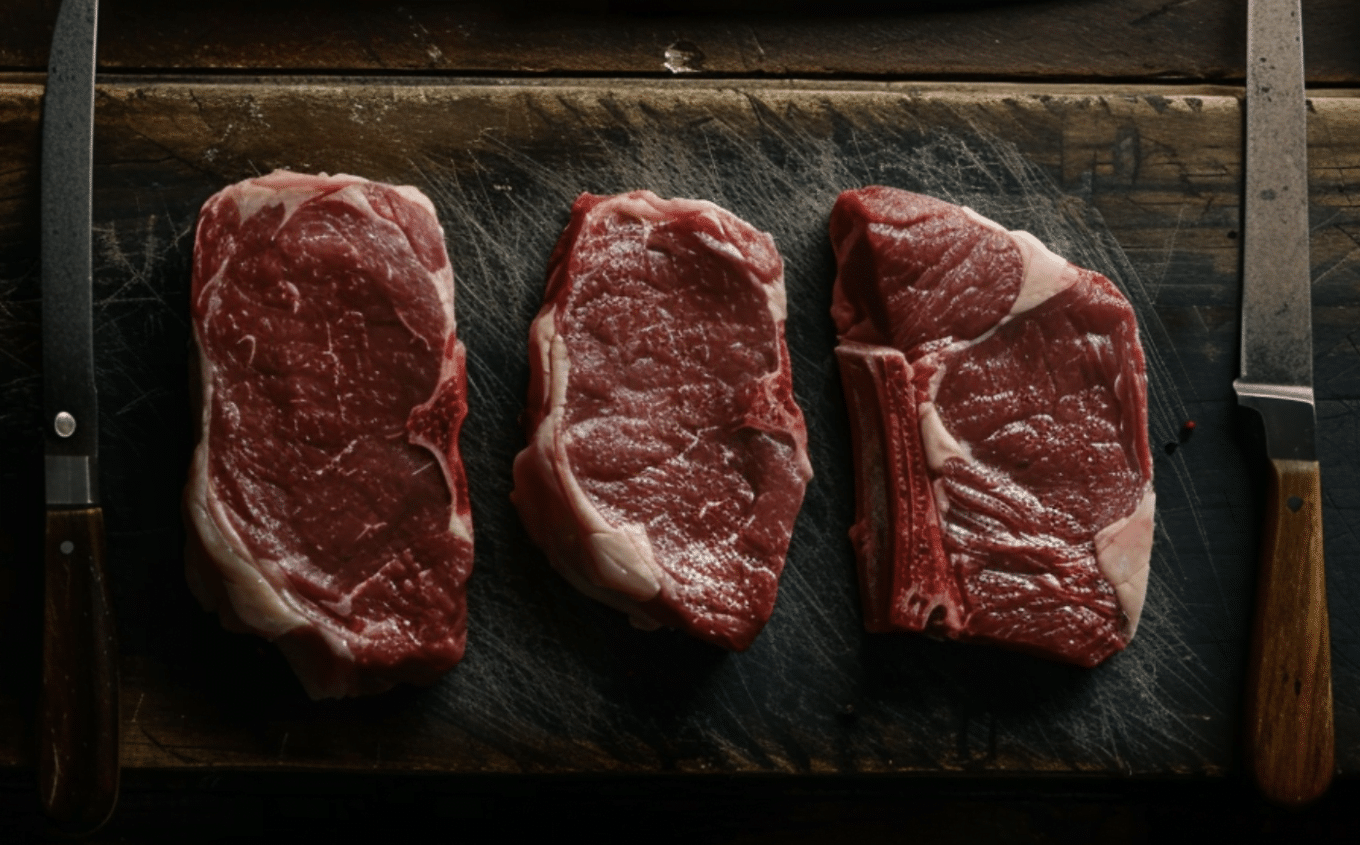Selecting the perfect steak cut can be daunting, especially with the many options available. Each cut offers a unique flavor profile and texture that can greatly impact your dining experience.
That’s why understanding the differences between various steak cuts is crucial for any meat lover.
In this comprehensive guide, we’ll explore the world of steak cuts, from the well-known ribeye to the lesser-known hanger steak.
You’ll learn about the characteristics of each cut, the best cooking methods to bring out their flavors, and how to choose the right steak for your preferences.
By the end of this article, you’ll be equipped with the knowledge to confidently select and prepare the perfect steak, ensuring a delightful and satisfying meal every time.
Top Steak Cuts
1. Ribeye

Ribeye is celebrated for its rich marbling, which provides exceptional flavor and juiciness. It is a favorite among steak enthusiasts.
The Ribeye steak is known for its rich, buttery flavor and tender texture, thanks to its high-fat content and extensive marbling.
This cut comes from the cow’s rib section, specifically between the 6th and 12th ribs. The area is less exercised, resulting in tender meat with abundant marbling.
Pros
- Flavor: The high marbling content ensures a rich, buttery taste.
- Tenderness: The Ribeye is one of the most tender cuts of steak due to the fat distribution.
- Juiciness: The fat content keeps the meat juicy and moist during cooking.
- Versatility: Suitable for various cooking methods, including grilling, broiling, and pan searing.
Cons
- Fat Content: While adding flavor, the high-fat content can lead to flare-ups on the grill and may be too rich for some people’s tastes.
- Price: Ribeye steaks can be more expensive than other cuts due to their quality and demand.
2. T-Bone and Porterhouse

The T-Bone and Porterhouse steaks are prized for combining two cuts: a strip steak and a tenderloin.
They are great choices for those who want to enjoy two different textures and flavors in a single cut.
Similarities
- Both cuts are taken from the short loin of the cow.
- Both contain a T-shaped bone that separates the strip steak (New York Strip) from the tenderloin (Filet Mignon).
- Both are ideal for grilling and broiling due to their thickness and flavor profile.
Differences
- Tenderloin Size: The Porterhouse has a larger tenderloin section than the T-Bone. To qualify as a Porterhouse, the USDA specifies that the tenderloin portion must be 1.25 inches thick at its widest point.
- Cut Location: Porterhouse steaks are cut closer to the rear end of the short loin, while T-Bones are cut closer to the front.
- Thickness: Porterhouse steaks are generally thicker than T-Bones.
Pros of T-Bone
- Combines two steak cuts in one, offering both flavor and tenderness.
- It’s usually more affordable than Porterhouse steaks.
- Versatile for various cooking methods.
Cons of T-Bone
- Smaller tenderloin sections can be less satisfying for those who prefer tender cuts.
- Requires careful cooking to ensure both cuts reach the desired doneness without overcooking.
Pros of Porterhouse
- The larger tenderloin section offers more tender meat.
- It is ideal for sharing due to its size.
- Delivers an excellent combination of flavors and textures in one cut.
Cons of Porterhouse
- It’s more expensive than T-Bone steaks.
- The thicker cut requires longer cooking times and more skill to cook evenly.
3. Filet Mignon

Filet Mignon is renowned for its unparalleled tenderness and mild flavor, making it a highly prized cut of steak.
The Filet Mignon is the most tender cut of steak, known for its buttery texture and mild flavor.
It is often considered the “king” of steaks.
This cut comes from the smaller end of the tenderloin, a long, cylindrical muscle that runs along the cow’s spine, from the ribs to the rear.
Pros
- Tenderness: The most tender cut of beef, often described as “melt-in-your-mouth.”
- Flavor: Mild flavor that pairs well with seasonings, sauces, and marinades.
- Appearance: Its small, round shape makes for an elegant presentation.
- Versatility: Can be cooked using various methods, including pan searing, grilling, and broiling.
Cons
- Price: Typically one of the most expensive cuts due to its tenderness and limited availability.
- Flavor: Some may find the flavor too mild compared to other, more robust cuts.
- Size: Smaller portion sizes may not be as filling as other cuts.
4. New York Strip

The New York Strip is known for its firm texture and rich, beefy flavor, making it a popular choice among steak lovers.
The New York Strip steak, also known as the strip loin or Kansas City Strip, is prized for its combination of tenderness and bold flavor.
It has a good amount of marbling, which adds to its rich taste.
This cut comes from the short loin section of the cow, located behind the ribs. It is a part of the larger muscle that includes the tenderloin.
Pros
- Flavor: Rich, beefy flavor that is more pronounced than some other cuts.
- Texture: Firm yet tender, providing a satisfying bite.
- Versatility: Can be cooked using various methods, including grilling, pan searing, and sous vide.
- Appearance: Often comes with an attractive fat cap that adds flavor during cooking.
Cons
- Thickness Variability: These may come in varying thicknesses, which can affect cooking times and evenness.
- Price: Generally more expensive than cuts like sirloin but less than ribeye or filet mignon.
- Chewiness: Can be slightly chewy if not cooked properly.
5. Top Sirloin

Top Sirloin is a flavorful and versatile cut known for its balance of tenderness and beefy taste, making it a popular choice for various cooking methods.
Top Sirloin is a lean cut with a robust, beefy flavor. It is more affordable than premium cuts like Ribeye or Filet Mignon but still delivers excellent taste and texture.
This cut comes from the sirloin section, located near the cow’s rear, just above the tenderloin.
The sirloin area gets more exercise than the loin, resulting in a leaner but flavorful steak.
Pros
- Flavor: Rich, beefy flavor that stands out in various dishes.
- Affordability: More budget-friendly compared to other premium cuts.
- Versatility: Can be used in a wide range of recipes and cooking methods.
- Leanness: Lower fat content makes it a healthier option.
Cons
- Tenderness: Less tender compared to Ribeye or Filet Mignon, can become tough if overcooked.
- Marbling: Less marbling, which may result in a slightly drier texture.
- Cooking Sensitivity: Requires careful cooking to avoid becoming too chewy.
6. Flank Steak

Flank Steak is a lean, flavorful cut that is well-suited for marinating and grilling, making it a versatile choice for various dishes.
Flank Steak is a long, flat cut with a rich beefy flavor and a relatively lean composition.
It has a pronounced grain, which makes it important to slice against the grain to ensure tenderness.
This cut comes from the lower chest or abdominal muscles of the cow, specifically the flank section.
The flank area is well-exercised, resulting in a lean but flavorful cut.
Pros
- Flavor: Known for its strong, beefy flavor that stands out in many dishes.
- Leanness: A lean cut with less fat, making it a healthier option.
- Versatility: Works well in a variety of recipes, especially those that benefit from marinating.
- Quick Cooking: Cooks quickly on high heat, making it convenient for weeknight meals.
Cons
- Tenderness: Can be tough if not cooked and sliced properly. Requires marinating and proper slicing against the grain to enhance tenderness.
- Thickness: Typically a thinner cut, which can lead to overcooking if not carefully monitored.
- Chewiness: Has more connective tissue, which can result in a chewier texture compared to more tender cuts.
7. Beef Chuck Primal Cut

The Beef Chuck Primal Cut is known for its robust flavor and versatility, making it ideal for slow cooking and roasting.
The Beef Chuck Primal Cut is a large section of the cow that includes the shoulder, neck, and upper arm areas.
It is known for its rich, beefy flavor and higher fat content, which contributes to its tenderness and taste when cooked properly.
This cut comes from the shoulder and neck area of the cow, which gets a lot of exercise, resulting in a flavorful but tougher meat that benefits from slow cooking methods to break down the connective tissues.
Pros
- Flavor: Rich, beefy flavor that stands out in many dishes.
- Affordability: Generally more affordable compared to more tender cuts like Ribeye or Filet Mignon.
- Versatility: Can be used in a variety of dishes, from roasts to stews and braises.
- Moisture: Retains moisture well when cooked slowly, resulting in tender, juicy meat.
Cons
- Tenderness: Naturally tougher due to the high amount of connective tissue and muscle. Requires long, slow cooking methods to become tender.
- Cooking Time: Longer cooking times needed compared to other cuts, which may not be ideal for quick meals.
- Fat Content: Higher fat content may not be suitable for all dietary preferences.
8. Flat Iron

The Flat Iron steak is a relatively new, innovative cut that is highly prized for its tenderness and robust flavor, making it a favorite for grilling and pan-searing.
The Flat Iron steak is known for its exceptional tenderness, second only to the Filet Mignon.
It has a rich, beefy flavor and good marbling, making it juicy and flavorful.
This cut comes from the top blade muscle of the shoulder (or chuck).
The Flat Iron was developed through innovative butchering techniques to remove tough connective tissue, resulting in a steak that is both tender and flavorful.
Pros
- Tenderness: Extremely tender, comparable to more expensive cuts like the Filet Mignon.
- Flavor: Rich, beefy flavor that is well-marbled.
- Versatility: Suitable for various cooking methods, especially grilling and pan searing.
- Affordability: Generally more affordable than premium cuts like Ribeye or Filet Mignon, offering excellent value for its quality.
Cons
- Size: Typically smaller in size, which may not be ideal for larger servings.
- Thickness: Can vary in thickness, which may require careful cooking to ensure even doneness.
- Availability: Sometimes less commonly found in supermarkets compared to other popular cuts.
Conclusion
Understanding the various cuts of steak is essential for any meat lover or home cook.
From the tender and mild filet mignon to the rich and flavorful ribeye, each cut offers a unique taste and texture that can enhance your dining experience.
By learning about the origins, characteristics, and best cooking methods for each cut, you can confidently select the perfect steak for your preferences and ensure a delicious meal every time.
Whether you’re grilling, pan-searing, or slow-cooking, the key is enjoying preparing steak and exploring the vast world of cuts available.
So, the next time you’re at the butcher or grocery store, use this guide to help you make an informed decision and begin a flavorful steak journey.
Frequently Asked Questions
What are the Top 5 Most Tender Steaks?
The five tenderest steaks are Filet Mignon, Ribeye, Flat Iron, Top Sirloin, and New York Strip.
What is the Most Expensive Cut of Steak?
The most expensive cut of steak is usually Filet Mignon, which is known for its exceptional tenderness and mild flavor.
Is Ribeye Better than Sirloin?
Ribeye is generally considered better than sirloin due to its rich marbling and flavor, but sirloin offers a leaner, more affordable option.
What is the King of Steaks Cut?
The Porterhouse is often called the “King of Steaks” because it combines the Filet Mignon and New York Strip in one large cut.




